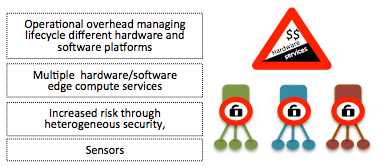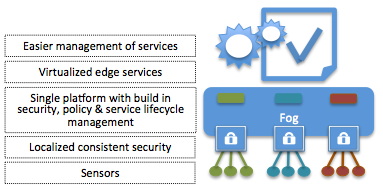When it comes to the Internet of Things (IoT), cities have enormous potential. A city needs to manage many different processes and priorities ranging from trash collection to traffic management, for hundreds of thousands to millions of people distributed over a large area. Many of these processes can be enhanced through the use of IoT.
During the past several years we have seen more and more technology solutions being deployed to help cities optimize these processes and provide additional value to its citizens. Smart parking is perhaps one of the best known and perhaps the most visible for city inhabitants.
Typically an IoT solution stack for these processes is build on several layers: (1) sensors to measure, (2) for each type of sensor there is typically a compute infrastructure at the edge of the network near the sensors, to perform simple aggregation, protocol/access technology conversion and local processing/analytics, (3) connectivity (wireless, backbone) to transfer data to the cloud, (4) cloud for deeper analytics, business processes and long term data access.
No two cities however are the same and each city has its own unique challenges. Backbone network infrastructures are managed in different ways, and local views on privacy and security can differ substantially. Light poles form a natural infrastructure to connect sensors with the edge of the network as it provides power and physical security. However cities upgrade their physical infrastructures with different time tables, and upgrades take time (and money), which leads to different alternative IoT infrastructure deployments at the network edge. Each city is organized differently which means budgets are managed differently. The latter can be especially challenging if new services touch multiple departments.
But cities also face common IoT challenges. Different types of sensors typically come with their own edge hardware and service management software. If a city deploys multiple sensor platforms this leads to so-called box proliferation and service management siloes (what some people call the vertical approach to IoT). This is not only undesirable from an aesthetics point of view, but makes it harder (more costly) to manage the whole city IoT infrastructure.

More sensors also means an increased security risk. Certain sensors have little processing power (to save money and battery life) which can make them targets for security attacks. While network security can filter out a lot of attacks there is still an increased risk of infecting the whole city infrastructure, specifically on an application level through data obfuscation. Sensor platforms do offer a certain level of security, but it is not always the primary focus within the solution and dealing with multiple platforms leads to multiple different security solutions.
The above challenges make it harder to scale up IoT in cities. Therefore a paradigm shift is needed towards a hyper distributed architecture of smart nodes: The heterogeneous edge hardware and software platforms should be replaced by a platform on which the virtualized services of the providers can be deployed. This so-called fog platform has hardened security as well as common libraries, features and hardware that can be used by the service providers to deploy their virtualized edge services. The fog platform also provides uniform edge service life-cycle management, policy based data and service access, as well as multi tenancy, reducing the cost for a city to manage such an infrastructure.

The fog platform is a win-win for the city and its edge service providers. Service providers can focus on their core competence of sensors, data aggregation/processing and business logic while leveraging standard security and processing features from the fog platform as well as the possibility to easier share and combine data (sometimes referred to as the horizontal approach to IoT) between different services.
For the city, the fog platform will make it easier to manage and deploy new edge services, without adding new boxes on the network edge for each new service, thereby reducing the capital and operational cost for managing the city IoT infrastructure.
The value of the fog platform for a city is not only the direct operational and capital cost savings as well as hardened security, but equally important is the shorter deployment cycle of new edge services, and easier data sharing between the traditional service siloes. With such an approach the city can become a large distributed test-bed to incubate new innovative ideas on data fusion and processing and develop new services that contribute to the overall quality of life for its citizens.

This is very exciting! thanks for posting.
This post is very similar to Mark Zuckerberg plan as he initiated the internet to many countries where there is no internet at all. He is very successful in implenting this plan and many countries have connected to the world. Thanks!